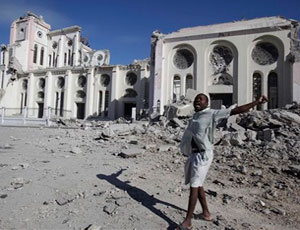Located along a fault line, the capitol of Haiti, Port-au-Prince, was the heart of the island nation. Now the heart is broken and any attempt to restore the country must revolve around its rebuilding.

.“Port-au-Prince is Haiti, and Haiti is Port-au-Prince,” says Bryant C. Freeman, perhaps the leading expert on Haiti in the U.S. He says the city and the country were heading in the right direction in recent years as decades of dictatorial oppression and violence faded away under the shelter of an umbrella of 9,000 United Nations observers and peacekeepers.
The people have a nickname for the city. “They call it the Republic of Port-au-Prince,” says Freeman.
“The traffic is terrible and there is the pollution and all of that, but everything is there. There are nine pretty decent bookstores…in the whole rest of the country there is one. It’s just as if Washington and New York were destroyed in one day; It couldn’t have hit a worse spot.”
A founder and director of the University of Kansas Institute of Haitian Studies in Lawrence, Kan., Freeman also served as instructor in Haiti for the United Nations observers and as advisor for U.S. and U.N. peace-keeping forces there with a protocol rank of Major General.
Freeman paints a picture of rapid urbanization, a phenomena that is occurring in cities across the developing world.
“The water supply was always bad in Port-au-Prince,” Freeman says. “The population was 200,000 people in 1958; now it’s 2 million. Water, electricity and sewerage have not begun to keep up with the people moving in from the country—where things are really bad. They think the city can’t be as bad, so they move there and settle in shantytowns in Port-au-Prince. People come in and they just put up a shack wherever they want.”
Building safety just isn’t on the agenda, says Freeman.
“Zoning laws are non-existing. There may be laws on the books but there is no enforcement. Maybe there are building codes…but I’ve have never heard of one.”
“From construction point of view, it’s just bad. Steel construction is very rare.” He says he has hardly ever seen rebar in use. Many homes the poor have built are simply made by stacking concrete masonry units. Only the wealthy have been able to afford the more expensive building materials, but also with little reinforcing, and judging from the news video he has seen, he says it looks like many of those have collapsed.
“The old houses built between 1920 and 1950 were built in wood, but ever since then construction has been in concrete and cinder blocks. Sometimes not even reinforced with mortar; just piled up on top of each other.
“Usually these catastrophes affect the poor more than the wealthy but in this case it’s not true. The wealthy are the ones living in the concrete houses.”
But he says the quality of life in the country had been getting better over the last couple of years and he would not have hesitated to steer prospective tourists to some good resort hotels there, prior to the Jan. 12 quake. “Infrastructure-wise, no improvement; but there has been a reduction in violence,” he says. “As of now? Who knows? People are getting desperate.”
The main hotel in the city that was a magnet for international travelers, business people and diplomats is the 5-Star, 140-room Hotel Montana, which sits atop a steep sided hill called Morne l’Opital. Many of the U.N. observers stayed there and that is where he schooled them in the local culture. “Very ornate. An International-class hotel. It was built in the 1930s and repeatedly enlarged and expanded. They say it’s destroyed. There must be a lot of people in there.”
Another signature structure was the Presidential Palace, which is largely destroyed. “It had marble floors and beautiful conference rooms. I have been in there many times,” he says. “The president sleeps in his own house in Pétionville,” he added. “He and his wife happened to have gone home. If he had been in the palace he would have been killed. His house was destroyed as well. Just a very old house.
According to an entry on Wikipedia, the palace was designed in 1912 by Georges H. Baussan (1874–1958), a leading Haitian architect who graduated from the Ecole d'Architecture in Paris.
The cathedral, he says, is another treasure of Port-au-Prince. “It took half a century to build that thing. Two walls are still standing. The archbishop happened to be in there. He’s dead.”
Also considered a local treasure are the few older wooden homes that have managed to survive the heat, humidity, rot and termites. They are in a local style called “Port-au-Prince Gingerbread Victorian” and are the product of a wave of young Haitian architecture students who went to Paris to study about 1910, and returned to create them. “They are charming, but unless they have been owned all along by a wealthy family that can keep them up, the termites, heat and tropical downpours have destroyed them.”
Their fate in the earthquake, like so much else, is unknown.
“The Haitians have said before that the only solution to the Haitian problem is an atom bomb,” he says. “Blow it up and start over.” In a sense, that is what has happened. “A company can go bankrupt and disappear. A country can’t…they can’t go anywhere and they are going to have to put things back together.”


Post a comment to this article
Report Abusive Comment